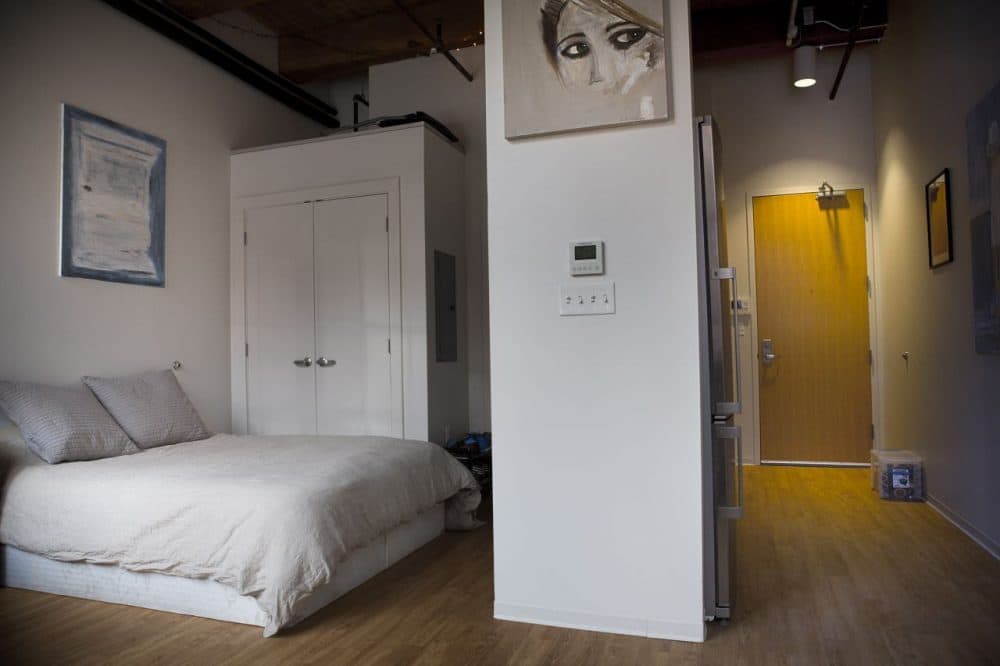Advertisement
Micro-Apartments: Boston's Housing Solution Or Developers' Cash Cow?
Resume
From New York to San Francisco, micro-apartments are the buzzword in urban planning. Developers and academics are pitching the tiny units as a solution for cities starving for housing.
Boston suffers from a huge housing shortage — an estimated 25,000 units. But here, the mini-apartment craze is restrained.
A year ago, the city's first so-called "innovation units" went up for rent. Now, a year later, there are only limited plans to build more.
Boston’s Cautious Approach
When the first 27 units went up for rent in the Seaport District, they were snatched up within weeks.
One guy who managed to get a studio apartment was Ross Chanowski, a 25-year-old who's launching his own 3-D printing company.
“It's kind of a live-work space in every sense of the term for me, from the conference room space to the co-working tables for meetings, you know if I need to have people in for a client dinner or something like that,” Chanowski said, describing the common space on the main floor of the building.
The thinking behind these "innovation units" is that they're not just tiny. They're efficient. And, where they sacrifice personal space, they make up for it in shared space.

Chanowski's place is a little smaller than 450 square feet. But, with loft-style ceilings, he said it doesn't feel cramped.
“You know it's a different style of living, so you have to get used to it,” he said. “You cut down on the things that you probably didn't need if you lived in a three-story townhouse, which I used to live in before I came here.”
Chanowski's apartment is minimalistic – he has a queen bed, a desk, a small couch and an arm chair. The apartment comes with a washer/dryer/dishwasher, all the basic appliances, and costs $1,700 a month. Chanowski thinks it's a deal, but analysts say it's not affordable for many Bostonians.
“People are discovering that these micro-apartments are renting for very macro rents,” said Tom Acitelli, founding editor of the real estate blog Curbed Boston.
He's skeptical about micro-housing.
“It sounded trendy,” he said. “They got them in New York, they got them in San Francisco, they got them in Seattle. They can work here. And this sort of panacea approach that's been offered, that they are the 21st-century solution to a city like Boston's housing crunch is ridiculous.”
So far the city has approved 353 micro-units — all in the Seaport District.
That term "micro" rubs Kairos Shen the wrong way. He's director of planning at the Boston Redevelopment Authority.
“The reason why I resist the categorization of these as micro-units is because it's only the physical characteristic that is being featured: micro,” he said. “As opposed to the notion that these are innovative in ways that foster high-quality living, even though it's in a small package.”
Shen prefers the term "innovation unit."
Right now, they're a pilot program, limited to just one neighborhood in the city. Economists say that's a problem; the city needs more.
Housing For Millennials
About a third of Bostonians are between the ages of 20 and 34. The city is home to the largest percentage of millennials in the country.
“What we need to really do is have an effort to build housing for this particular population in the same way that we went ahead and built that housing for the new working families coming to Boston a century ago,” said Barry Bluestone, a housing economist at Northeastern University.
"What we need to really do is have an effort to build housing for this particular population -- [millenials]."
Barry Bluestone, housing economist at Northeastern University
His argument is that the city does not need new housing for families. It already exists in the form of triple-deckers. The problem, Bluestone says, is that these days, young folks are teaming up with friends to rent triple-deckers and essentially pricing out families.
So he says the city should build new housing just for millennials.
“This would do two great things for the city,” he said. “One, it would provide even more attraction to young people to have housing built specifically for them. But, equally important if not more important, it would free up a lot of these triple-deckers and other housing like it for the working families who were the intended tenants to begin with.”
Bluestone estimates the city needs about 8,000 to 10,000 housing units for young people.
“It would increase the amount of housing supply to the point where by my statistical calculations rents would no longer continue to rise,” he said.
Bluestone said the price of triple-deckers, which has gone up by 46 percent in the last five years, would stabilize. Plus, the price of micro-units would also likely drop to about $1,200 a month.
But Shen, from the BRA, says it's not that easy to flood the market instantly with thousands of apartments.
“People are rushing to have us expand this program with very little inventory and experience of how these units are being occupied and whether in fact they are successful,” Shen said.
And, for the time being, he said he hasn't seen any indication that prices are stabilizing.
In fact, in 2012, Shen says the rent for a studio went up by 22 percent. On the other hand, the rent for a two-bedroom only increased by 10 percent, which shows there's demand for tiny units.
“We now have lots of developers who want to develop these small units, and they're thinking about creating micro-units, not innovation units, per se, to maximize the yield of the units that they're able to get in a development,” he said.
Shen knows there's money to be made renting these apartments, but he says micro-units alone will not solve the city's housing problem.
“One of the reasons why I'm not ready to pilot this elsewhere is because unless we have a creative agreement with the developers on managing the rents to make sure that this doesn't just become a cash cow just for the developers, we're not going to solve the housing problem,” he said.
Shen said, in theory, he's amenable to more micro-units if developers come up with a solution to control rents. But, for now, the city will move slowly and cautiously. There are 77 units under construction, 205 more approved, and no plans to expand beyond the Seaport District.
